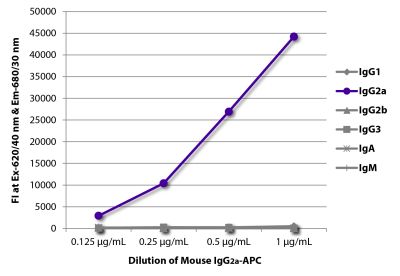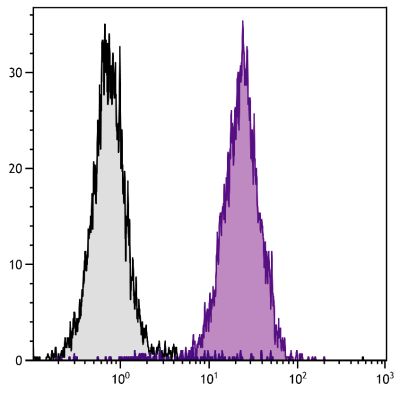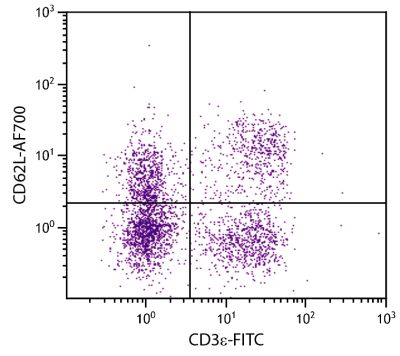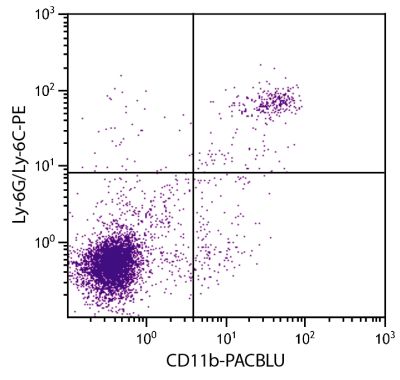Mouse Anti-Mouse CD45.1-APC (A20)
Cat. No.:
1795-11
APC Anti-Mouse CD45.1 antibody for use in flow cytometry assays.
$246.00
| Clone | A20 |
|---|---|
| Isotype | Mouse (A.SW) IgG2aκ |
| Isotype Control | Mouse IgG2a-APC (HOPC-1) |
| Specificity | Mouse CD45.1 |
| Alternative Names | Ly-5.1, LCA, SJL, T200 |
| Description | The CD45 antigen is an essential regulator of leukocyte activation and development and is now known to be a protein tyrosine phosphatase, e.g., CD45 is able to dephosphorylate the Src family of protein kinases. This activity is now known to be required for signal transduction induced by T and B cell antigen receptor engagement, cytokine signaling, and Fc receptor stimulation. The functional state of CD45 also has a pronounced effect on lymphocyte development. CD45 exists in multiple forms, such as the restricted variants (CD45R; see companion products 1660, 1665, 1675, 1685, and 1820) and as allelic forms CD45.1 (Ly-5.1) and CD45.2 (Ly-5.2). The former arises as a result of alternative splicing of different exons. The specificity of antibodies to CD45.1 and CD45.2 has been exploited in studies where resolution of donor and recipient cells is essential, such as in gene therapy or bone marrow transplantation. The monoclonal antibody A20 recognizes all mouse leukocytes expressing the CD45.1 allotype. |
| Immunogen | SJL mouse thymocytes and splenocytes |
| Conjugate | APC (Allophycocyanin) |
| Buffer Formulation | Phosphate buffered saline containing < 0.1% sodium azide and a stabilizer |
| Clonality | Monoclonal |
| Concentration | 0.1 mg/mL |
| Volume | 1.0 mL |
| Recommended Storage | 2-8°C; Avoid exposure to light; Do not freeze |
| Applications |
Flow Cytometry – Quality tested 3,5-9 Immunohistochemistry-Frozen Sections – Reported in literature 3,4 Immunohistochemistry-Paraffin Sections – Reported in literature 2 |
| RRID Number | AB_2795303 |
| Gene ID |
19264 (Mouse) |
| Gene ID Symbol |
Ptprc (Mouse) |
| Gene ID Aliases | loc; B220; Cd45; L-CA; Ly-5; T200; CD45R; Lyt-4 |
| UniProt ID |
P06800 (Mouse |
| UniProt Name |
PTPRC_MOUSE (Mouse) |
Documentation
Certificate of Analysis Lookup
Enter the Catalog Number and Lot Number for the Certificate of Analysis you wish to view
- 1. Shen F. Monoclonal antibodies to mouse lymphocyte differentiation alloantigens. In: Hämmerling GJ, Hämmerling U, Kearney JF, editors. Monoclonal antibodies and T-cell hybridomas: perspectives and technical advances. Amsterdam: Elsevier/North-Holland Biomedical Press; 1981. p. 25-31. (Immunogen)
- 2. Jodele S, Chantrain CF, Blavier L, Lutzko C, Crooks GM, Shimada H, et al. The contribution of bone marrow-derived cells to the tumor vasculature in neuroblastoma is matrix metalloproteinase-9 dependent. Cancer Res. 2005;65:3200-8. (IHC-PS)
- 3. Llodrá J, Angeli V, Liu J, Trogan E, Fisher EA, Randolph GJ. Emigration of monocyte-derived cells from atherosclerotic lesions characterizes regressive, but not progressive, plaques. Proc Natl Acad Sci USA. 2004;101:11779-84. (IHC-FS, FC)
- 4. Chen M, Lam BK, Kanaoka Y, Nigrovic PA, Audoly LP, Austen KF, et al. Neutrophil-derived leukotriene B4 is required for inflammatory arthritis. J Exp Med. 2006;203:837-42. (IHC-FS)
- 5. Angeli V, Llodrá J, Rong JX, Satoh K, Ishii S, Shimizu T, et al. Dyslipidemia associated with atherosclerotic disease systemically alters dendritic cell mobilization. Immunity. 2004;21:561-74. (FC)
- 6. Gautreau L, Arcangeli M, Pasqualetto V, Joret A, Garcia-Cordier C, Mégret J, et al. Identification of an IL-7-dependent pre-T committed population in the spleen. J Immunol. 2007;179:2925-35. (FC)
- 7. Gatza E, Rogers CE, Clouthier SG, Lowler KP, Tawara I, Liu C, et al. Extracorporeal photopheresis reverses experimental graft-versus-host disease through regulatory T cells. Blood. 2008;112:1515-21. (FC)
- 8. van Heijst JW, Gerlach C, Swart E, Sie D, Nunes-Alves C, Kerkhoven RM, et al. Recruitment of antigen-specific CD8+ T cells in response to infection is markedly efficient. Science. 2009;325:1265-69. (FC)
- 9. Gerlach C, van Heijst JW, Swart E, Sie D, Armstrong N, Kerkhoven RM, et al. One naive T cell, multiple fates in CD8+ T cell differentiation. J Exp Med. 2010;207:1235-46. (FC)
See All References






